🕒 Article read time: 2 minutes
Compliance advice summary: bridge strikes
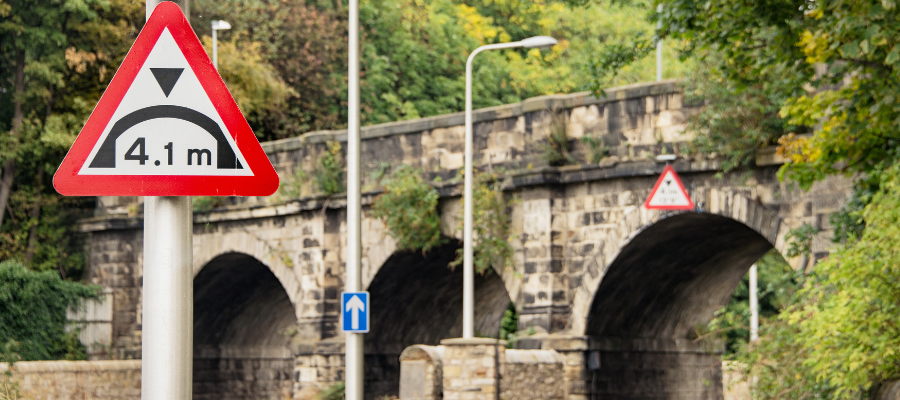
Ray Marshall, Senior Transport Adviser, Member Advice Centre
Bridge strikes, where vehicles, their loads or equipment collide with bridges, continue to be a significant and recurring problem. Drivers and rail passengers may experience frustration and delayed journeys, but a bridge strike has the potential to cause a train derailment with catastrophic consequences as well as loss of life or serious injury to the vehicle driver and other people nearby.
Recent landmark legal cases mean Network Rail can now claim back the huge costs incurred by bridge strikes, and they are aiming at claiming back 100%. It is important that your drivers know the height of their vehicle and understand and obey traffic signs. To assist them, the Department for Transport has amended the Traffic Signs Regulations to allow local councils to use new signs that show, for example, the maximum headroom in imperial and metric units.
In 2019, there were 1,787 bridge strikes reported. Of these strikes, 328 locations received multiple strikes, and the costliest single strike amounted to £1.8 million in train delay costs.
Most of the vehicles that hit railway bridges are Heavy Goods Vehicles and buses.
Network Rail’s research has shown 43 per cent of lorry drivers admit to not measuring their vehicle before heading out onto the road, and 52 per cent admit to not taking low bridges into account.
WHAT IS THE LAW?
For most vehicles, the road vehicles (Construction and Use) Regulations 1986 SI No.1078 as amended requires the maximum height of the vehicle in feet and inches to be displayed on a notice in the cab of a vehicle when the overall travelling height is more than three metres.
The Road Vehicles (Construction and Use) Regulations 1986 SI No.1078 as amended requires vehicles with high level equipment with a maximum height more than three metres to be fitted with a device to give a visible warning to the driver if the equipment is raised whilst being driven, unless the equipment can be fixed in position by a locking device.
It is an offence for a Transport Manager to cause or permit a vehicle to be used in breach of the regulations.
The Road Traffic Act 1988 requires any road traffic collision that causes damage to a third party to be reported. Each bridge strike will cause damage to a bridge, and therefore must be reported.
TRAFFIC SIGNS
Traffic signs are provided at bridges to show the maximum permitted vehicle height when less than 16’ -6” (5.05 metres).
If a vehicle is higher than the dimension(s) shown on a circular or triangular traffic sign, the driver must stop and must not pass the sign.
At arch bridges, white lines on the road and ‘goal posts’ on the bridge may be provided to indicate the extent of the signed limit on vehicle height, normally over a three-metre width. There may be an additional set of ‘goal posts’ showing lower limits towards the kerb.
- Red circles prohibit
- Red triangles warn

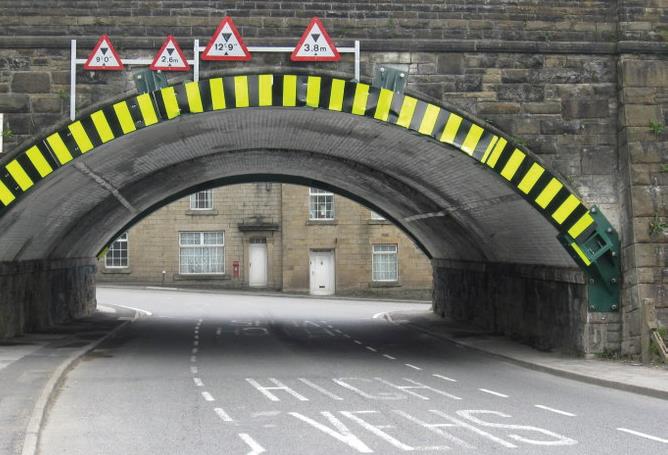
There are simple procedures and actions you can put in place to prevent bridge strikes before the journey begins, these will include route planning and checking vehicle heights.
ROUTE PLANNING
-
The risk of bridge strikes should be assessed based on the height and width of the vehicle, and its load or equipment
-
It is good practice to display the trailer height on the trailer headboard and the coupler height on the cab in a position easily visible to the driver
-
Routes should be planned in advance, and routes selected to eliminate the risk of bridge strikes
-
Routes for vehicles under maintenance or on test or diversion should be planned to avoid low bridges
-
Delivery schedules should not cause the driver pressure, stress or fatigue as this may increase the risk of bridge strikes
-
Make use of LGV specific satellite navigation systems that include information on vehicle height limits under low bridges
-
Atlases can be a valuable source of information for vehicle height limits under bridges
-
Advice on vehicle height limits under bridges may also be obtained from local highway or road authorities
-
Routes for vehicles with a travelling height over 16´-3˝ (4.95 metres) should be checked with the relevant highway or road authorities
VEHICLE HEIGHT CHECKS
You should ensure that drivers:
- check the maximum height of the vehicle, its load or its equipment before commencing a journey;
- advise you if the measured height is different from the height shown on the headboard;
- check the maximum height again after loading, unloading or reloading if the trailer suspension characteristics could change the height of the vehicle;
- display the correct height in the cab at the start of every journey and following any change in the load;
- are aware that at arch bridges the signed height is only available through part of the bridge and vehicle width must be considered;
- give special consideration to wide loads over three metres at arch bridges, as the maximum height available will be less than the signed height limit.
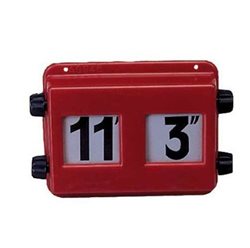
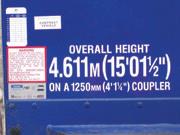
WHAT ACTION SHOULD BE TAKEN IF A BRIDGE STRIKE OCCURS?
At a railway bridge your driver should report the bridge strike immediately to the rail authority using the telephone number on the identification plate at the bridge. The driver should then report the bridge strike to the police using the 999 system and advise the operator of the strike.
For any other bridge, the bridge strike should be reported to the police using the 999 system, you should always monitor and investigate the causes of a bridge strike so that your company may learn lessons to avoid a repeat incident.
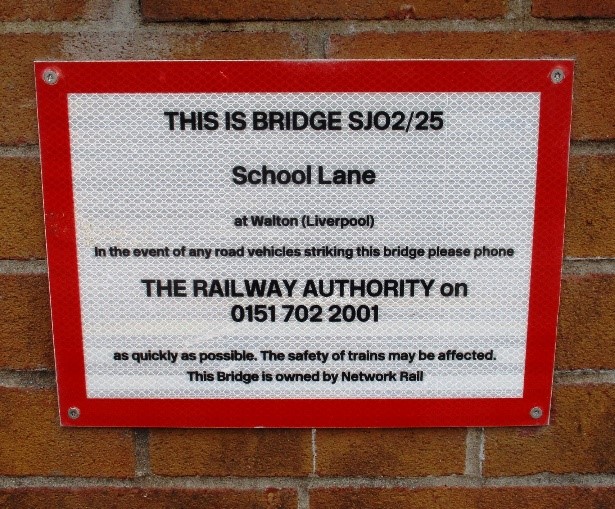
TRAFFIC COMMISSIONERS’ ADVICE
The Senior Traffic Commissioner for Great Britain sent a letter to all goods vehicle and PSV operator licence holders in September 2020 reminding them of their obligations as a responsible operator of large vehicles.
The letter explained how important the message was and that operators should ensure that it is understood and communicated to the workforce as appropriate.
The letter carried on to say that it is incumbent upon any operator to ensure that their vehicles are operated without unacceptable risks to road safety. These risks include the need to prevent bridge strikes, which bring with them potentially serious consequences as well as avoidable costs in terms of checking and repair, and delays to rail services and other road users. The risk from bridge strikes is not a new issue for the commercial vehicle industries.
Regulatory action is a real possibility for those operators who fail to take appropriate control measures to prevent bridge strikes, as well as for the drivers involved.
As part of these control measures operators should:
• assess the risks and ensure that routes are planned in advance, so far as is reasonably practicable;
• ensure that drivers, transport managers and planners are properly trained to enable them to assess the risks;
• ensure that drivers are being provided with adequate information including about the vehicles which they are driving.
In providing information that allows anyone planning or altering a route, operators should consider how to:
• ensure that drivers have access to height conversion charts;
• ensure that sites have height measurement gauges;
• ensure that each vehicle and trailer in the fleet has an established running height on its technical record;
• ensure that running heights are available to anyone planning a route including drivers who encounter unexpected or unmapped obstructions, such as temporary works.
Taking the time now to ensure that you have appropriate control measures in place will save you from the potential costs of regulatory action being taken by a Traffic Commissioner which could result in the loss of the operator’s licence or other actions that would impact upon your business.
In the statutory guidance issued by the Senior Traffic Commissioner, it states that Traffic Commissioners understand that the majority of collisions might be avoidable and caused as a result of negligence and poor training.
Traffic Commissioners expect drivers, operators and transport managers to make use of the guidance that is publicly available on how to avoid bridge strikes.
As a result, when incidences are brought to the attention of a Traffic Commissioner the driver can expect to be called to a hearing and may face a period of suspension. The Traffic Commissioner will also consider the culpability of the operator and transport manager and they may be called to attend a public inquiry.
*www.logistics.org.uk/mac
Published On: 16/09/2021 16:00:51
